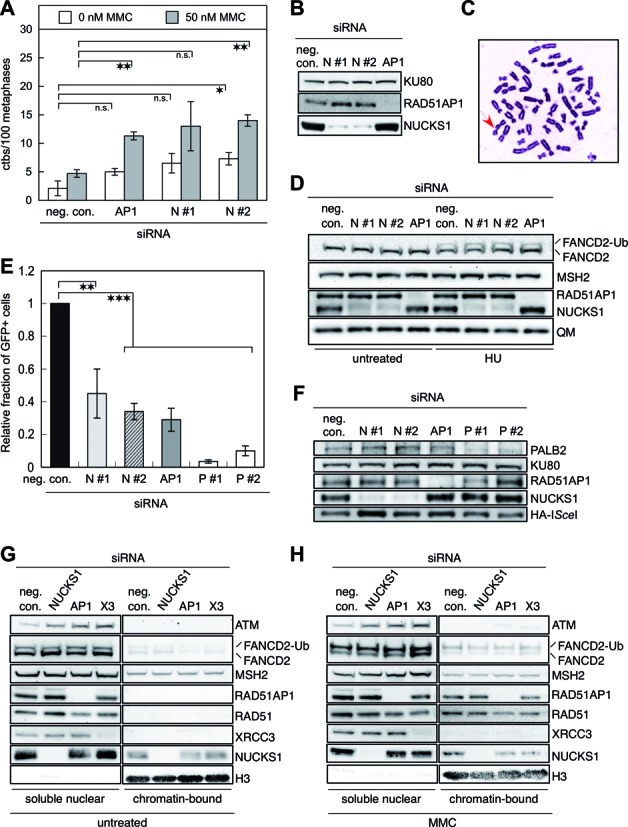Figure 3.

NUCKS1 is required for genome stability and HR repair, is localized to the chromatin fraction and dispensable for FAND2 ubiquitylation. (A) Chromatid-type aberrations are elevated after NUCKS1 knockdown in HCA2-hTERT fibroblasts. The effects of RAD51AP1 depletion (AP1) are shown for comparison purposes. **P ≤ 0.01; *P ≤ 0.05. Data are the mean from 3 (neg. con., AP1, and N #1 siRNA) and 2 (N #2 siRNA) independent experiments ± 1 SEM. (B) Representative Western blots obtained after knockdown of NUCKS1 or RAD51AP1 in HCA2-hTERT cells for the experiments shown in A. The signal for KU80 serves as a loading control. (C) Representative metaphase spread of NUCKS1-depleted HCA2-hTERT cells obtained after MMC treatment. Arrow: indicates chromatid break. (D) Western blots to show that the ubiquitylation of FANCD2 is not impaired in HeLa cells exposed to 2 mM HU and depleted for NUCKS1 by siRNA N #1 or N#2, or depleted for RAD51AP1 (AP1). Extracts from HU-treated cells were generated 5 h after treatment. The signals for MSH2 and QM serve as loading controls. (E) Homology-directed repair at DR-GFP is reduced in DR-U2OS cells depleted for NUCKS1 by one of two different siRNAs (N #1 and N #2). **P ≤ 0.01; ***P ≤ 0.001. The effects of RAD51AP1 depletion (AP1) or of PALB2 depletion by one of two different siRNAs (P #1 and P #2) are shown for comparison purposes. Data are from eight independent experiments ± 1 SD. (F) Representative Western blots obtained for the experiments shown in (E), ensuring similar expression of HA-ISceI in all cell populations. The signal for KU80 serves as a loading control. (G) Western blots obtained after cell fractionation to show that some NUCKS1 protein is associated with the chromatin fraction in HeLa cells under spontaneous conditions. The signals for MSH2 and histone H3 serve as loading controls. To obtain NUCKS1 knockdown, a pool of NUCKS1 siRNAs (N #1, #2 and #3) was used. (H) Western blots obtained after cell fractionation to show that NUCKS1 protein is associated with the chromatin fraction in HeLa cells that were treated with 1 μM MMC for 24 h. The signals for MSH2 and histone H3 serve as loading controls.
